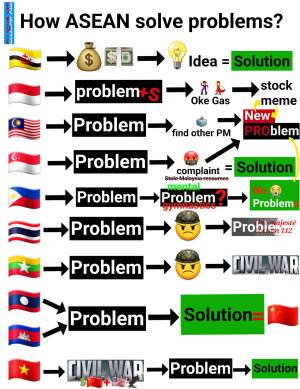ASEAN

ภาษาอาเซียน
The after story:
- ASEAN Professor randomly joined the TeamSpeak3 server thru Server Discovery Directory
- Nevertheless he got banned from server shortly after
- The girl in the video is known as C_______n was having an affair with someone who was on FiveM. They broke up with one of our professor.
- Nevertheless she got pregnant with ตลาดล่าง by เล่นชู้ thru FiveM.
China x ASEAN
- Chinese + Thais = Thainese (ชาวไทยเชือสายJ3K)
- Chinese + Indonesians = Chindos
- Chinese + Filipinos (Pinoys) = Chinoys
- Chinese + Bruneian = Bungnese
Why ASEAN Can't have Central Currency like EUR Did?
ASEAN's 400-Year Trade War: A Treasure Trove
For 400 years, the ASEAN region has been a battleground for trade. This historical fact might surprise some, but it's a testament to the region's rich resources and strategic location.
A History of Trade
Let's rewind to the Ayutthaya Kingdom, a bustling metropolis that once served as a central hub for trade in the region. This was around 400 years ago.
ASEAN's abundant natural resources, including forests, minerals, wildlife, and fertile land, made it a magnet for traders. From China to Europe, merchants flocked to the region seeking valuable commodities.
- The Chinese Dominance: Chinese traders were the first to arrive, leveraging their maritime expertise to establish trade routes and establish a dominant presence.
- The Japanese Challenge: The Japanese, known for their craftsmanship, entered the market with a focus on luxury goods like animal hides. This led to a brief period of competition between the Chinese and Japanese traders.
- The European Arrival: The arrival of Europeans, including the Portuguese, Dutch, and British, marked a new era in ASEAN trade. They sought spices and other valuable commodities, establishing trading posts and colonies.
- The Opium Wars and Beyond: The Opium Wars, which pitted Britain against China, had a profound impact on the region. The conflict disrupted trade routes and led to increased European influence in Asia.
- The Modern Era: In recent times, the ASEAN region has become a manufacturing hub, attracting foreign direct investment from countries like China, Japan, and South Korea. However, the trade war between the US and China has led to a shift in supply chains, with many companies relocating their production facilities to ASEAN countries.
The Absence of a Centralized Currency
Despite centuries of trade and economic integration, ASEAN has yet to adopt a single currency. This is due to a number of factors, including:
- Diverse Economies: ASEAN countries have vastly different economic structures and levels of development.
- Political Considerations: Implementing a single currency would require significant political coordination and consensus among member states.
- Currency Speculation: The fear of currency speculation and potential economic instability has also been a deterrent.
Conclusion
The ASEAN region has a rich and complex trading history, marked by competition, cooperation, and constant evolution. While the region has made significant progress towards economic integration, the absence of a centralized currency remains a significant challenge. As ASEAN continues to grow and develop, the question of whether or not to adopt a single currency will undoubtedly continue to be debated.